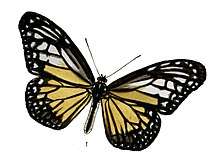Parantica aspasia
Parantica aspasia, the yellow glassy tiger, is a butterfly found in Asia that belongs to the crows and tigers, that is, the danaid group of the brush-footed butterflies family.
| Yellow glassy tiger | |
|---|---|
 | |
| Illustration from F. C. Moore - Lepidoptera Indica. Volume 1. 1890 | |
| Scientific classification | |
| Kingdom: | Animalia |
| Phylum: | Arthropoda |
| Class: | Insecta |
| Order: | Lepidoptera |
| Family: | Nymphalidae |
| Genus: | Parantica |
| Species: | P. aspasia |
| Binomial name | |
| Parantica aspasia (Fabricius, 1787) | |
| Synonyms | |
|
List
| |
Subspecies
Subspecies include: [1][2]
- P arantica aspasia annetta (Swinhoe, 1915)
- P arantica aspasia aspasia Morishita, 1970
- Parantica aspasia caulonia Fruhstorfer, 1911
- Parantica aspasia cerilla (Fruhstorfer, 1911)
- Parantica aspasia chrysea Doherty, 1891
- Parantica aspasia flymbra Fruhstorfer, 1910
- Parantica aspasia kheili Staudinger, 1885
- Parantica aspasia philomela Zinken-Sommer, 1831
- Parantica cleona rita Fruhstorfer, 1905
- Parantica aspasia shelfordi Fruhstorfer, 1905
- Parantica aspasia thargalia Fruhstorfer, 1910
- Parantica aspasia viridana Corbet, 1942
Distribution and habitat
This species is present in Myanmar, Thailand, Vietnam, Langkawi, W. Malaysia, Singapore, Borneo, Java, Bali, Philippines. [3][2] In Singapore is probably extinct. [4] These butterflies mainly inhabit forested areas. [5]
Description
_(7852036086).jpg)
Parantica aspasia has a wingspan of about 60–75 mm (2.4–3.0 in).[5][6] These butterflies have bluish grey wings, with a bright yellow and rather large basal patch and black markings.[5]
Biology
Adults can be found all year around, with a peak in September-October and in December. [7] The females lay a single whitish spindle-shaped egg. The caterpillar hatch after about four days. They mainly feed on Gymnema species,[2] Raphistemma species [5] and Tylophora species (Asclepiadaceae). [8]
After about 14 days and five instars the caterpillars pupate, anchoring themselves to the stem or leaves the host plant. The pupa is light green with black dots. After about eight days the adult butterflies emerge. [5]
Bibliography
- Butler, A.G.,1866 : A Monograph of the diurnal Lepidoptera belonging to the genus Danais, being a revision of the Insects of that Genus, with Descriptions of new species in the National Collection.- Proc. zool. Soc. Lond. 1866
- Fabricius, J.C.,1787 : Mantissa Insectorum sistens eorum species nuper detectas adiectis characteribus genericis, differentiis specificis, emendationibus, observationibus. Copenhagen, Christ. Gottl. Proft.
- Fruhstorfer, H.,1905 : Neue Rhopaloceren aus dem Indo-Australischen Gebiet. Ent. Zeit.
References
| Wikispecies has information related to Parantica aspasia |
| Wikimedia Commons has media related to Parantica aspasia. |
- Catalogue of life
- Funet
- A Check List of Butterflies in Indo-China
- Peter K. L. Ng, Richard Corlett, Hugh T. W. Tan Singapore Biodiversity: An Encyclopedia of the Natural Environment
- Butterflies of Singapore
- Khew Sin Khoon - A field guide to the Butterflies of Singapore
- iNaturalist
- Samui Butterflies
- Evans, W.H. (1932). The Identification of Indian Butterflies (2nd ed.). Mumbai, India: Bombay Natural History Society.